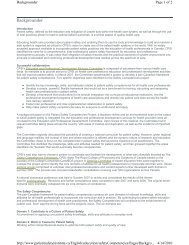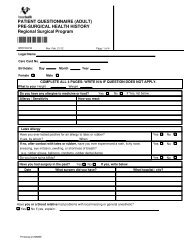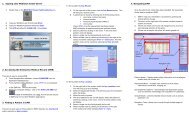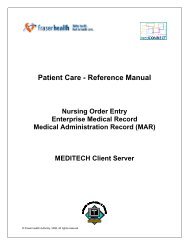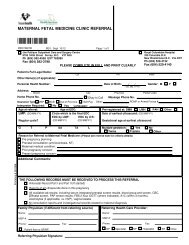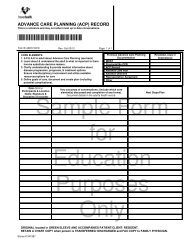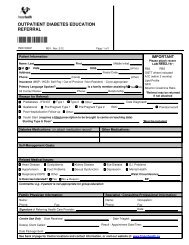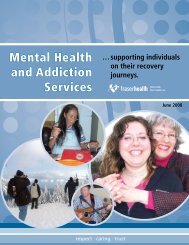Process - Physician - Fraser Health Authority
Process - Physician - Fraser Health Authority
Process - Physician - Fraser Health Authority
- No tags were found...
Create successful ePaper yourself
Turn your PDF publications into a flip-book with our unique Google optimized e-Paper software.
Mental <strong>Health</strong> and Substance Use Revised April 11, 2011Criteria for clinical diagnosis of Metabolic SyndromeClinical diagnosis of metabolic syndrome = Any three (3) or more of five risk factorsare present:Risk factor Defining levelRelated medicalconditionElevated waist Male: ≥ 102 cm (40 inches) Abdominal obesitycircumference a,b Female: ≥ 88 cm (35 inches)Elevated bloodpressureIf no co-morbid conditions: > 140/90If self measured: > 135/85If client has diabetes, renal disease orother target organ damage c : >130/80Hypertensionor drug treatment hypertensionElevatedtriglyceridesReduced highdensitylipoproteincholesterol (HDL-C)Elevated fastingglucose eHigh cholesterol /High cholesterol /(antihypertensive)> 1.7 mmol/Ltriglycerides dor drug treatment for elevatedDyslipidemiaMale: < 1.03 mmol/Lor drug treatment for reduced HDL-C dFemale: < 1.29 mmol/LDyslipidemia≥ 5.6 mmol/L or drug treatment forelevated glucoseDiabetesNotes:a If waist circumference is difficult to obtain, abdominal obesity may be ‘eye-balled’ or if BMI is ≥30 kg/m 2 , it can be initially assumed.b The <strong>Health</strong> Canada defining levels for waist circumference are recommended for use with allCanadian adults (except for pregnant and lactating women) and are used in these guidelines.Ethnic-specific data is available in the guidelines.c Target organ damage includes: cerebrovascular disease, coronary heart disease (CHD), leftventricular hypertrophy (LVH), chronic kidney disease (CKD), peripheral vascular disease andhypertensive retinopathy.d The most commonly used drugs for elevated triglycerides and reduced HDL-C are fibrates andnicotinic acid. A patient taking one of these drugs can be presumed to have high triglyceridesand low HDL-C.e Most with type 2 diabetes mellitus will have metabolic syndrome by this criteria.Follow up legendWithin normal range:No actionNo follow up required with respect to the specific risk factorFurther action required Refer to <strong>Physician</strong> for follow up, as per BC guidelinesTreatment required<strong>Physician</strong> treatment requiredRisk levels and associated recommended monitoring frequenciesRisk level DefinitionAny of the following conditions are present:High risk • On psychotropic meds AND presence of any risk factors or on treatment for any risk factors; OR• New start on psychotropic medications with high or moderate risk of weight gain (see Tables 7 and 8)Any of the following conditions are present:Moderaterisk• New start on all other psychotropic meds (those with low risk of weight gain – see Tables 7 and 8); OR• On psychotropic medications but no changes in past 3 months 1 ; OR• Greater than or equal to 5% increase in weight seen 2Low risk • No metabolic risk factors present; AND not on psychotropic medicationsRisk factorFrequency of monitoring by risk level 4High risk Moderate risk Low riskWeight, waistcircumferenceBC overweight andobesity guidelines• Baseline 5• Monthly for 3 months and untilstable• Then 3-monthly• Baseline 5• Then 3-monthly• Baseline 5• ThenannuallyBlood pressureBC hypertensionguidelinesLipids(triglycerides,HDL-C)BC cardiovasculardisease guidelinesFasting glucose(and Hb1Ac, ifphysicianrequests)• Baseline 5• Monthly for 3 months and untilstable• Then 3-monthly• Baseline 5• 3-monthly for 6 months and untilstable• Then annually• Baseline 5• 3-monthly for 6 months and untilstable• Then annuallyIf abnormal, screen/treat/refer as perBC diabetes care guidelines andscreening algorithmDiabetes-DKA • Baseline 5checklist 3 • Then monthly or at every visit• Baseline 5• Then 3-monthlyBaseline 5 (if no access to results fromprevious 6 months 6 ) and:• If ≥ 5% weight increase 2 or if lipidsabnormal: 6-monthly until stable, thenannually• Otherwise, annuallyBaseline 5 (if no access to results fromprevious 6 months 6 ) and:• If ≥ 5% weight increase 2 : 6-monthly untilstable, then annually• If fasting glucose abnormal: Screen/treat/refer as per as per BC diabetes careguidelines and screening algorithm• Otherwise, annually• Baseline 5• Then 3-monthly or at every visit• Baseline 5• Thenannually• Baseline 5• Thenannually• Baseline 5• Thenannually• Baseline 5• ThenannuallyNotes:1. Changes in psychotropic medications = Significant increase in dose proportional to baseline or change in medications.2. An unhealthy or risky weight gain = A rapid increase in weight (≥ 5%) over a short period of time.3. DKA = Diabetic ketoacidosis. Please see Table 9 for the Diabetes and DKA checklist.4. These are recommended monitoring guidelines. Ordering of monitoring is based on clinical assessment and exceptions may be justified byclinical circumstances. The frequency of testing depends on the individual client and the physician's assessment.5. Baseline is ideally at pre-treatment baseline, i.e., before or within 7 days of new medication start.6. Previous lab work should be no older than 6 months and if there is any reason for concern about previous lab work (e.g., changes inmetabolic risk factors or in other risk factors), lab work should be repeated to establish baseline, or at any point.




